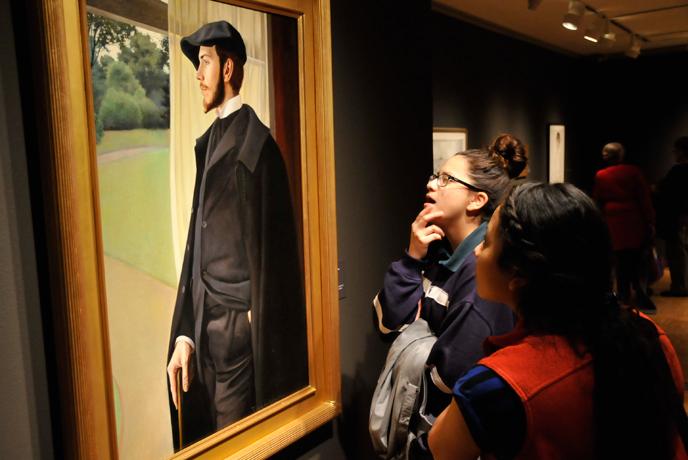Articulating an American Aesthetic

Senior-year project taps little-known artist's distinctively American work
By MaryAlice Bitts-JacksonThe 10 student curators for The Trout Gallery's current exhibition didn't just use secondary resources to help them prepare. They had something better: personal letters, notes, contemporary reviews and original works that cut to the heart of an acclaimed yet little-known artist's times and work.
The students were enrolled in the senior art-history seminar, a capstone course for art-history majors that requires all graduating seniors to research, organize and curate an exhibition and write an accompanying catalog. (Studio-art majors will show an exhibition of original works in the spring.) Their challenge? To find a way to present Frank von der Lancken (1872-1950) to the public.
One of the Southwest's most esteemed artists, von der Lancken was trained in New York and Paris and won many prestigious medals for his work. But instead of seeking out many commissions and exhibitions, he focused on his teaching career. Perhaps for this reason, there are no major publications devoted to him, and when Hirschl & Adler Galleries in New York presented a major exhibition of his work in 2001, it was the first public showing of the artist's paintings and drawings since 1941.
Clearly, this was not an easy topic to research.
Thanks to fellow Dickinsonian Eric Baumgartner '79, senior vice president and director at Hirschl & Adler, the students had access to 26 original paintings and drawings by von der Lancken; they studied them intently. With guidance from Professor of Art History Melinda Schlitt, they also pored over letters, reviews and clippings from a newspaper published by the Chautauqua Institution that included excerpts from von der Lancken's art lectures. And they spoke with von der Lancken's granddaughter Julie Kurtz, the executor of his estate, and Baumgartner, who offered additional information about the artist—and the commercial-art world—via a video conference with the class.
Piecing together this information, the students constructed an interpretive portrait of a man who was idealistic, experimental and forward-looking—an artist, in other words, who was emblematic of his country and of his time.
For the catalog, each student wrote essays about two works of art that focused on three themes they identified in van der Lancken’s work. The students also worked with Schlitt and James Bowman, registrar of The Trout Gallery, to design the exhibition layout, select colors for the walls and write the wall text. And then came the exhibition’s opening night.
According to Schlitt, these rigorous academic experiences and skill-building opportunities are rare for undergraduate art majors, and they reap great rewards for students pursuing careers in a notoriously competitive field. “One student in the course has already been hired by a commercial gallery in New York and plans to attend grad school in the field," she says. "Another was just accepted into the post-baccalaureate program at Christie’s auction house in London, and five others will apply to graduate school after a year of internships in museum studies, auction houses or academic graduate programs."
Art & art-history major Jessica Moran '13 is quick to add that the seminar also imparted skills that are important in every profession.
“This experience has taught me so much about collaboration and compromise,” she says, explaining that because each student was equally enthusiastic and passionate, there were many impassioned, sometimes diverse points of view to be heard and honored at every step. “Although there were certain decisions that we didn't see eye to eye on, in the end we were able to compromise and curate an exhibition that was better than we had ever envisioned.”
"It was a challenging assignment, but it was very rewarding, because the end product was spectacular," agrees fellow art & art-history major Sarah Howard '13. "I think this experience will help me in the future. It's great to put on your resume that you have published work."
Published February 22, 2013